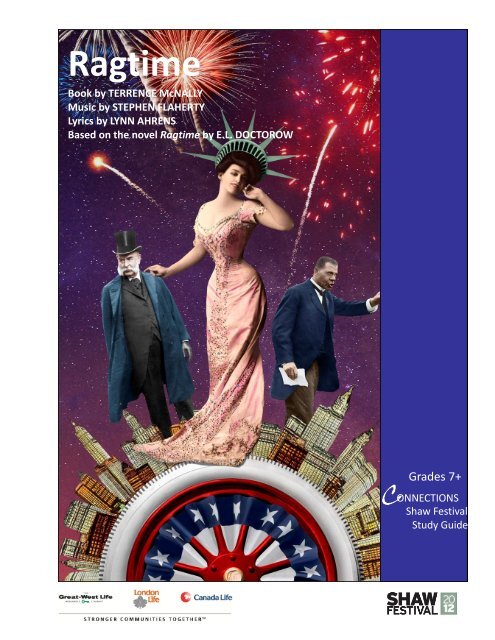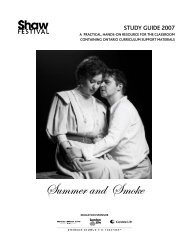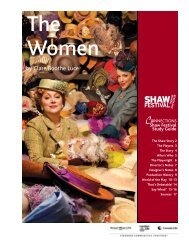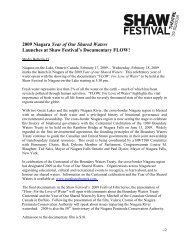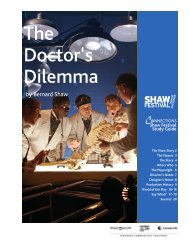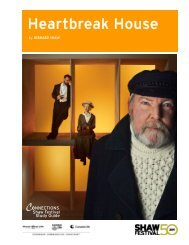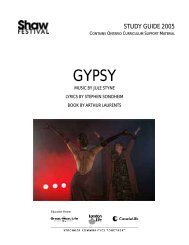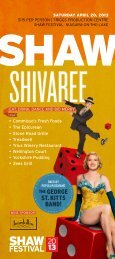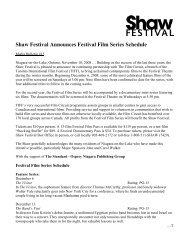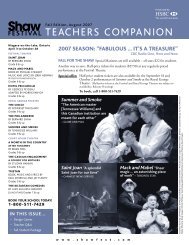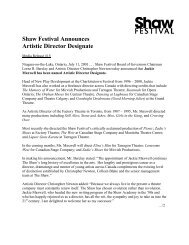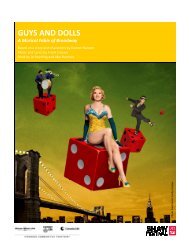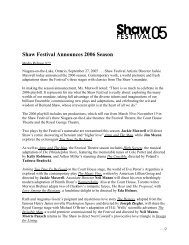Ragtime - Shaw Festival Theatre
Ragtime - Shaw Festival Theatre
Ragtime - Shaw Festival Theatre
You also want an ePaper? Increase the reach of your titles
YUMPU automatically turns print PDFs into web optimized ePapers that Google loves.
<strong>Ragtime</strong><br />
Book by TERRENCE McNALLY<br />
Music by STEPHEN FLAHERTY<br />
Lyrics by LYNN AHRENS<br />
Based on the novel <strong>Ragtime</strong> by E.L. DOCTOROW<br />
Grades 7+<br />
C ONNECTIONS<br />
<strong>Shaw</strong> <strong>Festival</strong><br />
Study Guide
EVERYONE LOVES A CELEBRATION<br />
At the <strong>Shaw</strong> <strong>Festival</strong> <strong>Theatre</strong>, we celebrate the work of the incredibly gifted playwright, George<br />
Bernard <strong>Shaw</strong> (he shall henceforth be referred to as Bernard <strong>Shaw</strong>, as that was his preference).<br />
HOW TO THINK LIKE A<br />
SHAVIAN<br />
<strong>Shaw</strong> said “… a civilization can not<br />
progress without criticism.”<br />
<strong>Shaw</strong> wrote and educated<br />
people about the injustices he saw<br />
in society.<br />
Sometimes injustice takes place<br />
because nobody knows about it.<br />
Sometimes injustice persists because<br />
people don’t know what to<br />
do about it.<br />
Are you aware of some kind of<br />
injustice in your life or in the world<br />
around you? If you had unlimited<br />
power to fix any unjust<br />
situation, what would<br />
you do?<br />
A bachelor, an Irishman, a vegetarian, a fluent liar, a socialdemocrat,<br />
a lecturer and debater, a lover of music, a fierce<br />
opponent of the present status of women, an insister on the<br />
seriousness of art. - <strong>Shaw</strong>, on <strong>Shaw</strong><br />
Bernard <strong>Shaw</strong> was a RADICAL REBEL WITH A CAUSE.<br />
At the <strong>Shaw</strong> <strong>Festival</strong>, we admire the spirit in which he wrote.<br />
He was a master EDUTAINER, writing to educate people about social and<br />
political issues and to inspire people to DO SOMETHING about injustice<br />
in the world and passivity about their circumstances—all while entertaining.<br />
He took great pleasure in ruffling the feathers of the establishment and<br />
getting people to think about social and political issues:<br />
a SUBVERSIVE PROVOCATEUR.<br />
That makes him very COOL in our estimation.<br />
“<br />
<strong>Theatre</strong> can change the world...<br />
<strong>Theatre</strong> can change people<br />
”<br />
who can change the world.<br />
-Jackie Maxwell,<br />
Artistic Director<br />
WHAT WOULD YOU DO?<br />
I WOULD_________________________<br />
2<br />
C ONNECTIONS<br />
<strong>Shaw</strong> <strong>Festival</strong> Study Guide
C ONNETIONS<br />
Study Guide<br />
A practical, hands-on<br />
resource for the classroom<br />
which contains<br />
background<br />
information for the<br />
play, as well as<br />
suggested themes for<br />
classroom discussions.<br />
<strong>Ragtime</strong> is<br />
recommended for<br />
students in grades 7<br />
and higher.<br />
This guide was written<br />
and compiled by<br />
Amanda Tripp. Additional<br />
materials were<br />
provided by Suzanne<br />
Merriam, <strong>Ragtime</strong><br />
Wardrobe Running<br />
crew, Paul Bryant, Peter<br />
Vietgen, Beau<br />
Dixon, Sue LePage and<br />
Joanna Falck.<br />
Cover image by Emily<br />
Cooper<br />
Previews: April 10/12<br />
Opens: May 26/12<br />
Closes: Oct 14/12<br />
THE PLAYERS<br />
Coalhouse THOM ALLISON<br />
Grandfather GUY BANNERMAN<br />
Willie Conklin / Ensemble NEIL BARCLAY<br />
Father BENEDICT CAMPBELL<br />
Ensemble JEREMY CARVER-JAMES<br />
Booker T Washington AADIN CHURCH<br />
Ensemble SACCHA DENNIS<br />
Ensemble IEJOMA EMESOWUM<br />
Ensemble ELODIE GILLETT<br />
Emma Goldman KATE HENNIG<br />
Sarah ALANA HIBBERT<br />
Mother PATTY JAMIESON<br />
Ensemble BILLY LAKE<br />
Sarah’s Friend / Ensemble NICHOLA LAWRENCE<br />
JP Morgan / Ensemble ANTHONY MALARKY<br />
Evelyn Nesbit JULIE MARTELL<br />
Matthew Henson / Ensemble STEWART ADAM McKENSY<br />
Ensemble BRANDYN McKINSON<br />
Ensemble MARLA McLEAN<br />
Henry Ford / Ensemble PETER MILLARD<br />
Ensemble LOUIE ROSSETTI<br />
Ensemble KIERA SANGSTER<br />
Younger Brother EVAN ALEXANDER SMITH<br />
Ensemble JIVARO SMITH<br />
Ensemble JACQUELINE THAIR<br />
Tateh JAY TURVEY<br />
Houdini / Ensemble KELLY WONG<br />
Ensemble JENNY L. WRIGHT<br />
Little Girl MORGAN HILLIKER / EDEN KENNEDY<br />
Little Boy JADEN CARMICHAEL / AIDAN TYE<br />
THE ARTISTIC TEAM<br />
Director JACKIE MAXWELL<br />
Musical Director PAUL SPORTELLI<br />
Choreographer VALERIE MOORE<br />
Set & Costume Designer SUE LEPAGE<br />
Lighting Designer ALAN BRODIE<br />
Projection Designer BETH KATES and BEN CHAISSON<br />
Sound Designer JOHN LOTT<br />
3<br />
C ONNECTIONS<br />
<strong>Shaw</strong> <strong>Festival</strong> Study Guide
“<br />
It was the<br />
music of<br />
something<br />
beginning, an<br />
era exploding,<br />
a century<br />
”<br />
spinning...<br />
-<strong>Ragtime</strong><br />
The Story<br />
RAGTIME<br />
The rhythms of ragtime weave their way through this powerful and sweeping<br />
musical epic about the beginnings of contemporary America. We see the<br />
struggles and successes of the country through the eyes of three archetypal<br />
American families—a white, upper-middle class family in New Rochelle, an<br />
African-American musician in Harlem, an Eastern European immigrant and his<br />
daughter in the Lower East Side. Intertwined with their stories are the successes,<br />
scandals and stars of the period—like magician Harry Houdini, civil<br />
rights leader Booker T. Washington, political activist Emma Goldman, mogul<br />
J.P. Morgan, inventor Henry Ford, and Evelyn Nesbit, the famous Girl on a<br />
Swing.<br />
Through each of the families and the rise and fall of these characters, the<br />
musical reveals how they all connect, with each other and with history. The<br />
family in New Rochelle—we only know them as Mother, Father, Younger<br />
Brother and Little Boy—learn to cope as Father leaves to travel to the Arctic<br />
with explorer Admiral Robert Peary. When Mother finds an African-American<br />
baby abandoned in her garden, she meets Sarah, the mother who can’t or<br />
won’t speak. Coalhouse Walker, a ragtime musician in New York, searches for<br />
Sarah, the woman he loved and when he finds her and his son, he sets out to<br />
win them back. Tateh, a Jewish immigrant from Latvia, comes to New York<br />
with his daughter and a dream—but life is harder than this artist expected,<br />
until he creates a little ‘movie’ and becomes part of the burgeoning movie<br />
business.<br />
We experience this America through the hope of immigrants to a new<br />
country, the magic of Harry Houdini, the amazing financial success of J.P.<br />
Morgan, the politics of Emma Goldman, the fight for freedom of Booker T.<br />
Washington—but also through the music that this Tony Award-winning score<br />
- from the ragtime rhythms of Harlem and Tin Pan Alley to the klezmer of the<br />
Lower East Side. And while this musical may have been written sixteen years<br />
ago, the themes in it feel almost more true, more important, more relevant<br />
now—hope and hardship, the possibilities of great economic success and the<br />
realities of those who don’t have enough; celebrity scandals and the hope<br />
that an African-American leader can bring to a country.<br />
TEACHERS, PLEASE NOTE:<br />
This play deals head-on with the problem of racism in the early 19th century. You<br />
and/or your students may find some of the language in this play uncomfortable to<br />
hear.<br />
Click on http://www.shawfest.com/education/study-guides/ragtime/ to hear <strong>Shaw</strong><br />
<strong>Festival</strong> Company members discussing the power of racist language. You could use<br />
this as a springboard for a class discussion.<br />
C<br />
4<br />
ONNECTIONS<br />
<strong>Shaw</strong> <strong>Festival</strong> Study Guide<br />
ONNECTIONS<br />
<strong>Shaw</strong> <strong>Festival</strong> Study Guide
Production History<br />
RAGTIME<br />
This musical had its world premiere in Toronto in 1996 and opened on<br />
Broadway on January 18, 1998. It led the 1998 Tony Awards with 13 Tony<br />
Award nominations and won for Best Score, Book and Orchestrations, and<br />
won both the Drama Desk and Outer Critics Circle Awards for Best Musical<br />
and Best Score. Recently, book writer and playwright Terence McNally<br />
(Master Class, Love! Valor! Compassion!) talked about the continuing<br />
importance of this kind of musical – “<strong>Ragtime</strong> is in the tradition of<br />
Showboat and South Pacific, stories with a lot of plot, a moral fabric to the<br />
center of them and a real involvement with the society we live in,” Mr<br />
McNally said. “This is not musical comedy, but we are part of a very long<br />
tradition with this show.” Directed by Artistic Director Jackie Maxwell, the<br />
cast features Thom Allison as Coalhouse Walker, Patty Jamieson as Mother<br />
and Jay Turvey as Tateh.<br />
ACTIVITY<br />
ASK: What other musicals can the class name that deal with issues of<br />
morality and challenging social themes?<br />
Why might a creative team choose the musical format to explore difficult<br />
social topics and themes?<br />
Pictured above: Posters from the original Broadway (left) and Toronto (right)<br />
productions of <strong>Ragtime</strong><br />
5<br />
C ONNECTIONS<br />
<strong>Shaw</strong> <strong>Festival</strong> Study Guide
WHO’S WHO?<br />
In RAGTIME<br />
In <strong>Ragtime</strong>, the stories of fictional American families are blended with the lives of<br />
actual historical figures. The principal fictional characters are:<br />
COALHOUSE WALKER JR<br />
A Harlem ragtime composer-pianist<br />
struggling for dignity and justice.<br />
MOTHER<br />
When Father leaves the family to go<br />
on an expedition to the North Pole,<br />
Mother becomes head of the household<br />
and of the family business.<br />
Both she, and her family go through<br />
many changes. She represents the<br />
ideals of the Progressive Era,<br />
inclusiveness and embracing change.<br />
SARAH<br />
A young washerwoman who has a<br />
child with Coalhouse and who<br />
becomes the innocent victim of<br />
Conklin’s racist act.<br />
WILLIE CONKLIN<br />
Racist and bigoted, fire chief Conklin<br />
acts hostilely toward Coalhouse. His<br />
behavior endangers those around<br />
him and is a catalyst for violence<br />
which occurs in the story.<br />
TATEH & THE LITTLE GIRL<br />
A Latvian Jewish immigrant and his<br />
daughter who travel to the United<br />
States in search of the American<br />
Dream.<br />
MOTHER, FATHER and MOTHER’S YOUNGER BROTHER<br />
The family represents the status quo (white-upper-middle-class America) that is being challenged by radical changes in<br />
society in the late 19th & early 20th centuries.<br />
Each member of the family responds to the sweeping changes of the period differently.<br />
FATHER<br />
Represents the traditional Victorian<br />
norms of a late 19th century white<br />
upper-middle-class family man. He<br />
seems challenged and somewhat lost<br />
as to how to cope with the changes<br />
taking place in society at large and in<br />
his own home.<br />
Their fictional lives become entwined with these actual historical figures<br />
MOTHER’S YOUNGER BROTHER<br />
An idealistic young man with little<br />
self direction. He falls in love with<br />
Evelyn Nesbit, but eventually<br />
becomes disillusioned with her.<br />
Later he joins Coalhouse’s group of<br />
revolutionaries, battling injustice and<br />
comes to feel that his life has a sense<br />
of purpose.<br />
6
EMMA GOLDMAN<br />
Anarchist Emma Goldman immigrated<br />
to the US from Russia and began a life<br />
of political dissent.<br />
She fought for women’s right to be<br />
financially independent from men.<br />
Having suffered with other women in<br />
harsh ‘sweat shops’ in the garment district of New York<br />
City, she helped organize labour unions to fight for<br />
workers’ rights. As a feminist, she persuaded women to<br />
use birth control and to take control of their bodies. As<br />
a pacifist, she protested the draft when the U.S. entered<br />
WWI. She rejected societal institutions such as<br />
wage slavery, religion, marriage, private property and<br />
militarism. She spent a lot of time in jail! She was deported<br />
back to the USSR in 1919, became a British subject<br />
through a fake marriage. The final years of her life<br />
were spent in Toronto.<br />
http://www.youtube.com/watch?v=wFoMfoQSCh8<br />
BOOKER T.<br />
WASHINGTON<br />
America's most<br />
prominent African<br />
American orator<br />
and educator.<br />
He was born a slave on a Virginia plantation. After<br />
Emancipation, he laboured as a coal miner by day and<br />
at night was taught to read and write by a local school<br />
teacher. He worked his way through college as a janitor<br />
and went on to advocate for black rights, political and<br />
legal change through peaceful means.<br />
http://www.youtube.com/watch?v=_Hsd55AK53U<br />
HARRY HOUDINI<br />
Born Ehrich Weiss, Houdini became<br />
a professional magician in 1891.<br />
Among his most sensational illusions<br />
were "The Vanishing Elephant"<br />
and his escape from a milk<br />
can in a strait jacket. This amazing<br />
feat will be performed in <strong>Ragtime</strong>.<br />
http://www.youtube.com/watch?<br />
v=XMuh-l-Eqfs<br />
EVELYN NESBIT<br />
Model and chorus girl, Evelyn Nesbit<br />
married the jealous, volatile Henry<br />
Thaw. Her romantic entanglement with<br />
the famous architect, Stanford White,<br />
ended with White’s murder at the hands<br />
of Thaw. The press labeled it "The Crime<br />
of the Century." The original Gibson Girl,<br />
Nesbit was the era's living definition of what was beautiful<br />
and fashionable. The Gibson Girl personified beauty, independence,<br />
personal fulfillment (she was depicted attending<br />
college and vying for a good mate, but she was never depicted<br />
as part of the suffrage movement).<br />
http://www.youtube.com/watch?v=z04robb91Z8<br />
J.P. MORGAN<br />
Capitalist and financial mogul. He<br />
was the most powerful figure in<br />
American finance and industry.<br />
FUN FACT: The Monopoly guy,<br />
“Rich Uncle Pennybags” was<br />
modeled on J.P. Morgan!<br />
http://www.youtube.com/<br />
watchv=st3_8LEQvck&feature=related<br />
http://www.biography.com/people/john-pierpontmorgan-9414735<br />
HENRY FORD<br />
Automobile inventor and innovator. Introduced<br />
the first moving automobile assembly<br />
line.<br />
http://www.biography.com/people/henry-ford-9298747/<br />
videos/henry-ford-a-car-for-the-people-2087064480<br />
ADMIRAL ROBERT PEARY<br />
An American explorer. He’s best known for<br />
his claim to be the first man who reached<br />
the North Pole in 1909.<br />
http://www.youtube.com/watch?v=jtT5Zj_9vo<br />
ACTIVITIES - In preparation for the performance, ask your students to research the significance of each of these<br />
historical characters and share their findings with the class.<br />
7<br />
C ONNECTIONS<br />
- Have students choose a historical character to incorporate into their own work of fiction. Discuss why<br />
they chose this person. What did they change about them? Why? What attributes remained true to life<br />
or historical accounts?<br />
<strong>Shaw</strong> <strong>Festival</strong> Study Guide
RAGTIME<br />
WRITERS<br />
PLAYWRIGHT Terence McNally (b.1939) was born in Florida, grew up in Texas and went to school in<br />
New York City. After graduating from Columbia University he took a writing fellowship in Mexico,<br />
came back to New York to do an apprenticeship at the Actor’s Studio and became a tutor to author<br />
John Steinbeck’s children. As a playwright, his first major success came with Frankie and Johnny in the<br />
Clair de Lune (1987) which he adapted into a film featuring Al Pacino and Michelle Pfeiffer. Other<br />
plays include Lips Together, Teeth Apart (1991), Love! Valour! Compassion! (1995) and Master Class<br />
(1996) – the latter two winning the Tony Award for Best New Play. In 1997, McNally stirred controversy<br />
with his play Corpus Christi, which imagines Jesus and his Apostles as gay men living in modernday<br />
Texas. His work on musicals includes librettos for Kiss of the Spider Woman (1993, Tony Award,<br />
Best Book of a Musical) and <strong>Ragtime</strong> (1998, Tony Award, Best Book of a Musical), The Full Monty, The<br />
Rink, The Visit, A Man of No Importance and the opera Dead Man Walking. Recently, his new play<br />
Golden Age was featured in a Kennedy Center celebration of his work and his new musical, Catch Me<br />
If You Can, opened on Broadway in 2011.<br />
LYRICIST Lynn Ahrens (b.1948) was born in New York City. She began her career as a lyricist when she<br />
worked on a children's television show and began writing songs for Schoolhouse Rock (including A<br />
Noun is a Person, Place or Thing). Ahrens met COMPOSER Stephen Flaherty (b.1960) at a musical<br />
theatre workshop in 1982 and they started working together the following year. Born in Pittsburgh,<br />
Flaherty studied music at NYU and played ragtime piano in a dance band. Their first musical together<br />
was Lucky Stiff (1989), and premiered Off-Broadway. Their next musical, Once on This Island (1990)<br />
premiered on Broadway and was nominated for eight Tony Awards. <strong>Ragtime</strong> followed, opening on<br />
Broadway in January 1998 and running for 834 performances. They followed this with Seussical: The<br />
Musical which opened on Broadway on November 2000, and it became one of the most performed<br />
musicals in the U.S. Ahrens and Flaherty's next musicals, A Man of No Importance (2002), Dessa Rose<br />
(2005), and The Glorious Ones (2007) were produced at the Newhouse <strong>Theatre</strong> at Lincoln Center and<br />
they wrote original songs for the Chita Rivera autobiographical show, Chita Rivera: The Dancer's Life.<br />
They also collaborated on songs for the animated movie Anastasia, receiving Academy Award and<br />
Golden Globe nominations for Best Song and Best Score. Currently they are at work on two new musicals:<br />
one based on the film Rocky and another based on the painter Edgar Degas.<br />
NOVELIST E.L. Doctorow (b.1931) is known for blending fiction and fact in his novels about the<br />
history of America, combining real and fictional characters. Selected books include: The Book of<br />
Daniel (1971), based on the Julius and Ethel Rosenberg case; <strong>Ragtime</strong> (1975), named one of the hundred<br />
best novels of the 20th century; World's Fair (1985; National Book Award), a semiautobiographical<br />
work set in the Bronx of the 1930s; Billy Bathgate (1989), a tale of Prohibition-era<br />
gangsters; The March (2005), a fictionalized account of General Sherman's Civil War march through<br />
Georgia; and Homer & Langley (2009), his version of the lives of two New York hoarder-hermit brothers.<br />
8 C ONNECTIONS<br />
<strong>Shaw</strong> <strong>Festival</strong> Study Guide
“<br />
The Tony<br />
winning score<br />
of Lynn Ahrens<br />
and Stephen<br />
Flaherty is just<br />
as diverse as<br />
the melting pot<br />
of America<br />
itself.<br />
-Music <strong>Theatre</strong><br />
International<br />
Musical Notes ”<br />
RAGTIME<br />
<strong>Ragtime</strong> is both the name of the musical and the name of a particular style of<br />
music. <strong>Ragtime</strong> music developed in the U.S. towards the end of the 19th century<br />
and was extremely popular right up until 1917, the start of World War I.<br />
This style of music combines elements from both African-American and European-American<br />
musical traditions. At the time, this was a ‘new sound’ and it<br />
created quite a sensation! The meeting of different cultures that was taking<br />
place on American soil around the turn of the century was reflected in the<br />
meeting of African and European musical traditions that made up ragtime. It<br />
was one of the first musical styles invented in the United States to have an important<br />
impact on music abroad and on musical history.<br />
The name ‘ragtime’ refers to the ‘ragged’, or off-the-beat, syncopated rhythm.<br />
It is believed that its name is a contraction of the term ’ragged time’ which refers<br />
to the rhythmically broken up melodies. To ‘rag’ a piece of music is to<br />
play with its rhythms. This is one of the most important characteristics of ragtime.<br />
It has a strong steady ‘boom-chick-boom-chick’ rhythm, like a march.<br />
Against this strong, steady rhythm, there is a ragged melody of syncopated<br />
rhythms.<br />
The best-known and most easily found ragtime pieces are by Scott Joplin, such<br />
as Maple Leaf Rag and The Entertainer were reintroduced to society in the<br />
movie “The Sting”.<br />
Click here to learn more about ragtime music with <strong>Shaw</strong> <strong>Festival</strong> Music<br />
Interns, Beau Dixon and Scott Christian:<br />
http://www.shawfest.com/education/study-guides/ragtime/<br />
ACTIVITIES<br />
DISCUSS Why do you think the author chose the title “<strong>Ragtime</strong>” for this work?<br />
What is ragtime music? What are its origins and how does it relate to other<br />
genres of music? What does it reveal about the society in which it was created?<br />
LISTEN to ragtime music with your class.<br />
DISCUSS how this style of music reflects the society in which it was created<br />
and the issues of the day.<br />
1) Ask your students to choose a few contemporary songs. Discuss how they<br />
relate to these songs and how they reflect our society and our experiences.<br />
Examine style, rhythm and tempo, instrumentation, lyrics, etc.<br />
2) Examine examples of music that are tools for social commentary/criticism,<br />
such as folk music and the protest songs of the ‘60s, punk, rap, etc.<br />
SOURCES<br />
http://cnx.org/content/m11619/latest/<br />
http://www.randomhouse.com/catalog/teachers_guides/9780812978186.pdf<br />
9<br />
C ONNECTIONS<br />
<strong>Shaw</strong> <strong>Festival</strong> Study Guide
Directors’ Notes<br />
JACKIE MAXWELL<br />
talks about directing <strong>Ragtime</strong><br />
One of the signature songs of <strong>Ragtime</strong> is Wheels of a Dream, sung by Coalhouse<br />
and Sarah as they hold their tiny baby and look into his glowing future.<br />
As I have delved further and further into this beautiful, complex piece, the notion<br />
of dreams...the need for them and their fulfillment, has revealed itself in<br />
different ways.<br />
There is the personal dream of doing <strong>Ragtime</strong> at the <strong>Shaw</strong> <strong>Festival</strong> with a cast<br />
of ensemble members old and new, all wrestling with its joy, despair and<br />
hope together. A dream of telling this potent story of the beginning of contemporary<br />
America—with its mix of myth and cold, hard reality—here on<br />
America’s doorstep. A dream that has resulted in a creative process more collaborative<br />
than any I have previously experienced, as we untwine the deeply<br />
intimate stories within and feed them through our vision of the kaleidoscopic<br />
world they all inhabit.<br />
But always, just as we do at the end of the play, we come back to Coalhouse<br />
and Sarah’s dream—a bright, new future for their son. How wonderful then<br />
that since this musical was written in 1996, that dream has been realized in a<br />
way that neither character could have possibly imagined. Even the musical’s<br />
creators would have been hard put to project that, in November 2008, Barack<br />
Obama would become the first African-American President of the United<br />
States. Wheels of a Dream indeed—a dream we salute and celebrate with this<br />
production.<br />
10<br />
C ONNECTIONS<br />
<strong>Shaw</strong> <strong>Festival</strong> Study Guide
Design Notes<br />
SUE LePAGE<br />
talks about Designing <strong>Ragtime</strong><br />
<strong>Ragtime</strong> is easily one of the most complex plays that Jackie Maxwell and I have<br />
encountered in our many years of working together. The musical has many settings<br />
and our challenge was to depict the different locations in a dynamic way.<br />
To avoid constantly changing scenery, we decided to use people, costumes,<br />
and a backdrop of projected imagery to capture the flow of the story and to<br />
indicate changes in location. The set is an open, simple structure - with a series<br />
of levels and lots of exits and entrances to allow flexibility of movement<br />
and staging.<br />
There are many characters in <strong>Ragtime</strong> and the use of colour in the costumes<br />
will help the audience identify the various family/societal groups. For instance,<br />
the immigrants’ palette is cool and drab while the Harlem group is made up of<br />
much more rich, earthy tones.<br />
Click here for clips of Sue explaining the set and costume design:<br />
http://www.shawfest.com/education/study-guides/ragtime/<br />
FUN DESIGN FACTS<br />
� over 80 hours of discussion were spent between designer Sue LePage and<br />
director Jackie Maxwell to develop the design and staging to the play<br />
� over 200 costumes were designed for 28 actors<br />
� more than 50% of the costumes come from our costume warehouse and<br />
have been re-worked for this show<br />
� 17 racks were needed to store the costumes during rehearsals<br />
� the set is a multi-level series of platforms and bridges which scale the<br />
height of the <strong>Festival</strong> <strong>Theatre</strong><br />
� 176 quick changes (a costume change in under 3 minutes) occur during the<br />
first act alone!<br />
� one inspiration for the design came from model train tracks<br />
ACTIVITIES<br />
See pp 27 - 33<br />
Before the show:<br />
Post copies of these sketches around the classroom or distribute them to the<br />
class. Ask the students to write a mini bio about one of the characters based<br />
on what they can glean about that person by looking at them.<br />
After the show:<br />
ASK: How much of what you deduced based on the character’s appearance<br />
was true? How might costumes help to tell the story of the play?<br />
11<br />
C ONNECTIONS<br />
<strong>Shaw</strong> <strong>Festival</strong> Study Guide
FUN FACTS from WARDROBE RUNNING<br />
Once a production is on stage, all the costumes need to be maintained on a daily basis. Laundry,<br />
small repairs, ironing, sorting, resetting costumes into dressing rooms, and assisting with quick costume<br />
changes - these are the responsibilities of Wardrobe Running.<br />
RAGTIME has 180 costume<br />
changes in the first act alone; 80<br />
of these are 3 minutes or less,<br />
including a few that are only 30<br />
seconds long! Many of the actors<br />
looking calm and collected on<br />
stage, have just frantically had<br />
their clothing ripped off and an<br />
entire new outfit put on in less<br />
time than it would take someone<br />
to turn on a cell phone and<br />
make a call.<br />
<strong>Ragtime</strong> uses approximately 24 full wigs and 25 different<br />
moustaches. None of the actors have their own facial hair and<br />
change their moustaches and side burns with their characters.<br />
They are mostly secured with toupee tape. Every moustache has<br />
to be cleaned and set for every show. Nothing is worse than<br />
when a moustache goes missing backstage because it can<br />
accidentally become stuck to anything and travel out on stage<br />
when it’s not supposed to (sometimes sticking to a jacket, skirt or boot!). Extra care is always taken<br />
to place facial hair in a specific spot during quick changes to avoid ‘unplanned stage appearances’.<br />
While the audience watches the show in front of the curtain, there is a well-choreographed ‘silent<br />
dance’ going on between the actors and stage crew behind the scenes. Major set pieces are silently<br />
rolled around, props are removed, carried about and pre-set, costumes are laid out or returned to<br />
the dressing rooms, and around all of this commotion actors are getting changed or moving into<br />
position to prepare for their next entrance. One wrong move could throw the entire rhythm off.<br />
The action backstage has to occur quietly so as not to disturb the action on stage, often during a<br />
musical like <strong>Ragtime</strong>, the actor’s body microphones are switched on and they are singing while they<br />
are moving about behind the curtain to provide background vocal to the music/singing that the audience<br />
sees happening onstage. There is a lot of communication that happens using hand signals<br />
and body language—all of which is done in very dim light!<br />
Contributed by the <strong>Shaw</strong> <strong>Festival</strong>’s <strong>Ragtime</strong> Wardrboe Running crew<br />
When all three shows at the <strong>Festival</strong> <strong>Theatre</strong> are up and<br />
running, each day Wardrobe Running’s staff of 5 will press and<br />
fold approximately 60 dress shirts, 40 pairs of socks, not to<br />
mention hosiery, hankies and other ’unmentionables’ that will<br />
be returned to the dressing rooms in time for the next<br />
performance. It’s at this time that repairs are done, shoes<br />
shined, suits and gowns touched up and a variety of other bits<br />
and pieces spruced up from the show the night before.<br />
After every <strong>Ragtime</strong> performance, 7 loads of laundry are done,<br />
plus a large basket of hand washing. Long after the audience<br />
members are in their cars and on their way home, Wardrobe<br />
Running is at work, preparing for the next show.<br />
12
“The tumultuous early years of the 20th century in America were marked by<br />
confidence, energy, and ambition.<br />
These were years of social change, immigration, exploration,<br />
and technological progress,<br />
alongside class warfare, racial discrimination, and anarchy”.<br />
- Lois Kivesto<br />
UNDERSTANDING THE WORLD OF THE PLAY<br />
<strong>Ragtime</strong> tells the story of three families struggling to adapt in a rapidly changing society. Early 20th<br />
century America was booming with technological innovation and industrialization, faced with civil<br />
rights struggles, injustice, and social unrest. On the stage, we see the beginning of a number of social<br />
movements: feminism, radicalism, the civil rights and labour movements, as well as other components<br />
of the struggle for reform. To paint a picture of the times:<br />
- In July 1900 the US census totals 76 million<br />
- There are more telephones than bathtubs<br />
- There are more blacksmiths than doctors<br />
- There are eight thousand cars, and less than 10 miles of concrete road in the entire United States of<br />
America<br />
- Most Americans still live in rural areas without running water, indoor plumbing, or electricity<br />
- Machines begin to replace farm workers<br />
- Trains provide transportation<br />
- Seven million people move to cities nationwide<br />
- The wealth of the country is in the hands of a small number of financiers who have established<br />
monopolies. Among the most prominent of these men were John D. Rockefeller, Andrew<br />
Carnegie, Andrew Mellon, and the most powerful of them all, John Pierpont Morgan—a real historical<br />
figure who appears as a character in <strong>Ragtime</strong>.<br />
SOCIAL CHANGE<br />
Refers to a significant change in the behavior patterns and cultural values or norms of a society—<br />
changes that have profound sociological consequences. Examples of significant social changes having<br />
long-term effects include the industrial revolution, the abolition of slavery, and the feminist<br />
movement. Social change can be driven by a number of forces, including: culture, religion, economy,<br />
science, and technology.<br />
SOURCES:<br />
http://pbskids.org/bigapplehistory/index-flash.html— continue research here<br />
http://www.pbs.org/wgbh/amex/1900/tguide/tguideprogram.html<br />
http://www.randomhouse.com/catalog/teachers_guides/9780812978186.pdf<br />
13<br />
C ONNECTIONS<br />
<strong>Shaw</strong> <strong>Festival</strong> Study Guide
Turn of the century feminism was an important<br />
movement for social change. At this time, the feminist<br />
movement was focused on women’s suffrage, securing<br />
the right for women to vote and run for office.<br />
At the same time in history, the fantasy of the “Gibson<br />
Girl” (a stylish, independent woman) is created by<br />
magazine illustrator Charles Dana Gibson (<strong>Ragtime</strong>’s<br />
real life character, Evelyn Nesbit is the original Gibson<br />
Girl). In reality, most women in 1900 are still very<br />
dependent upon men. Many women hope to “marry<br />
Feminist Suffrage Parade. NYC, May 6, 1912 well” in order to better their lives, yet some women<br />
choose careers instead of husbands. Not an easy decision as many high-paying careers were closed<br />
to women at this time.<br />
ACTIVITIES<br />
RESEARCH: What kinds of jobs did women typically hold in 1900? What roles did women have at<br />
home, at work, and in society in 1900? What groups in society benefited from denying women the<br />
right to own property, belong to a union, or vote? When did women gain the right to vote in Canada?<br />
Are you surprised by the answer?<br />
What rights have women achieved by 1900? What rights will women still have to fight for? Make a<br />
class list. What rights do women still have to fight for today?<br />
Write a monologue or dialogue contrasting the life of a nurse, teacher, factory worker, or secretary<br />
around 1900 with the life of a woman in that job today. Have students do an oral presentation of<br />
their work to the class.<br />
IMMIGRATION<br />
Immigrants land in New York at Ellis Island, where people are sorted, re-named, detained and even<br />
sent home if they are old or ill. The frustrations of poverty and illness greet and overwhelm many<br />
newcomers who struggle just to survive in a country that they believed was the answer to their<br />
prayers.<br />
- Half a million immigrants arrive during 1900, part of the largest wave of immigration in American<br />
history.<br />
- Nearly one-third of these immigrants return home.<br />
- Millions of people move west looking for a better life and many immigrants become workers in<br />
America’s industrial revolution. They work 12-16 hours a day, 6 days a week, for as little as $1.35 a<br />
day. Thousands of people each year are maimed by machines, burned by molten steel, or buried by<br />
coal mine explosions.<br />
- America runs on coal. Fuel companies recruit workers from Europe, paying their way to America in<br />
exchange for work in the coal mines. There are no federal mine regulations and few state laws to protect<br />
workers and their families.<br />
SOURCE: http://pbskids.org/bigapplehistory/immigration/topic7.html<br />
14<br />
C ONNECTIONS<br />
<strong>Shaw</strong> <strong>Festival</strong> Study Guide
THE WORLD OF THE PLAY cont’d<br />
TECHNOLOGICAL PROGRESS<br />
1900 is a time of technological, scientific, and industrial advances. Trains allow citizens to vacation in<br />
any part of the country. Household electricity and indoor plumbing revolutionize the way people live.<br />
New inventions include movie projectors, electric fans, phonographs, light bulbs, automobiles and<br />
telephones. Americans believe these inventions will make them smarter, happier and healthier.<br />
Henry Ford introduces the innovative model of assembly line manufacturing, seeing that it is more<br />
efficient for one worker to do one task repeatedly as opposed to trying to manage several tasks. This<br />
assembly line organization limits decision-making for workers and improves productivity, making Mr.<br />
Ford a very wealthy man—although not the wealthiest. That distinction belongs to J.P. Morgan, the<br />
legendary Wall Street financier.<br />
These developments had consequences for the average American worker. Ford’s assembly line style<br />
of manufacturing, for example, was based on the principle that the parts of the finished product<br />
were interchangeable, but that the people who built the products were also interchangeable. Each<br />
person a cog in a machine. The implication being that this devalues the individual and his abilities.<br />
Anyone could do the job.<br />
Source:<br />
http://www.sparknotes.com/lit/ragtime/themes.html<br />
ACTIVITIES<br />
KEEP A 24-HOUR RECORD of all the mechanical devices that you use in an ordinary day.<br />
Find out how many of the devices on your list were invented throughout the 1900s.<br />
(refer to timeline of inventions on the following page, or have students research and create their own<br />
timeline)<br />
DISCUSS: Of the following technological advances—railroads, mechanized farm tools, factory machines,<br />
cars, or telephones—which do you feel changed the lives of Americans the most? Specifically,<br />
what did the inventions change in people’s lives and how did these changes alter America as a country?<br />
How did these changes alter the lives of women?<br />
Far left: Ford Model T Assembly Line<br />
Left: Tea Bag Patent, 1903<br />
Above: early paper towels<br />
C<br />
15<br />
ONNECTIONS<br />
<strong>Shaw</strong> <strong>Festival</strong> Study Guide
1890 Smoke detector<br />
TIMELINE OF INVENTIONS (1890 - 1917)<br />
1891 Tesla coil—transmits electrical energy without wires for communications, broadcasting<br />
Zipper<br />
1892 Dimmer<br />
Padded Bicycle Seat<br />
Tractor<br />
1897 Muffler<br />
Ice Cream Scoop<br />
1898 Remote Control<br />
Filing Cabinet<br />
1900 Nickel– zinc battery (a rechargeable battery)<br />
Thumbtack<br />
1901 Assembly line<br />
Safety razor<br />
Windowed envelope<br />
1902 Air conditioning<br />
1903 Tea bag<br />
Airplane<br />
Windshield wipers<br />
1904 Automatic transmission<br />
AC power plugs and sockets<br />
Banana split<br />
1906 Flushometer—water pressure system using a handle to flush toilets/urinals<br />
1907 Curtain rod<br />
Paper towel<br />
1910 Telephone headset<br />
1911 Road surface marking (i.e. painting a yellow line down the centre of the road)<br />
1912 Autopilot<br />
Electric blanket<br />
Traffic light<br />
1916 Supermarket (self-service store. Previously, customers shopped at a general<br />
store where a clerk would fetch inventory for customers to purchase)<br />
Light switch<br />
16 C ONNECTIONS<br />
<strong>Shaw</strong> <strong>Festival</strong> Study Guide
THE WORLD OF THE PLAY cont’d<br />
CLASS WARFARE<br />
Throughout 1900, workers demand better working conditions and higher pay, resulting in labour<br />
disputes. Uniting workers proves to be an enormous challenge because the workers are divided along<br />
racial and ethnic lines.<br />
Working conditions are, in many cases, intolerable; pay is inadequate; life in the tenements is<br />
unbearable; violence and poverty run rampant. As a result, workers begin to organize and strike;<br />
demanding that business pay attention to the health and safety of workers.<br />
RACIAL DISCRIMINATION<br />
After the Civil war (1865), African Americans voted, sent representatives to Congress, and served as<br />
sheriffs and justices of the peace. By 1900 all of that comes to an end. In the South, segregation and<br />
“Jim Crow” regulations restrict civil rights and prevent African Americans from voting. Hostility<br />
toward people of colour, religious minorities and immigrants grows along with organizations such as<br />
the Ku Klux Klan. Klan members resort to lynching and other acts of terrorism. The last remaining<br />
African American congressman, George White, introduces a bill to make lynching a federal crime, but<br />
the motion is defeated. In his farewell speech, White challenges colleagues about the injustice African<br />
Americans suffer. It is the last speech that any black man gives to Congress for the next 28 years!<br />
Booker T. Washington, author of the well-known autobiography Up From Slavery, creates the<br />
Tuskegee Institute in 1881, dedicated to teaching African Americans practical, marketable skills.<br />
Washington urges his followers to create businesses and to become self-reliant people. He mentors a<br />
new African American leader, W.E.B. Du Bois. Du Bois believes that without political power African<br />
Americans will never achieve equality and aims to fight injustice with scholarship and reason. By<br />
1899 he is a professor at Atlanta University. However, he witnesses a vicious crime—the lynching of<br />
African American Sam Hose— and this changes his mind about fighting bigotry through reason and<br />
writing, causing a split between himself and his mentor, Washington.<br />
In <strong>Ragtime</strong>, the struggle against racial discrimination is told through the story of Coalhouse Walker<br />
Junior, who is horribly abused and bullied by members of the Emerald Isle firehouse. Police repeatedly<br />
ignore his petition for help and, as a result, Coalhouse takes matters into his own hands.<br />
ACTIVITIES<br />
Post-Show<br />
ASK: Why do you think the men from the firehouse destroyed Coalhouse’s car?<br />
Have students collect examples of how different ethnic groups are portrayed in today’s media from<br />
newspapers, magazines or from commercials and sitcoms. What messages do these images send?<br />
Have students select an image of an ethnic or racial minority from contemporary culture and write a<br />
personal essay about what the image conveys—positive or negative. Were any images hard to find?<br />
What would students like to see depicted? Was it different than what they found?<br />
How do modern images of African Americans in popular culture compare to the images from America<br />
in 1900? Has there been an improvement in this depiction? Why or why not?<br />
17<br />
C ONNECTIONS<br />
<strong>Shaw</strong> <strong>Festival</strong> Study Guide
Anarchists agree: big business and government are<br />
harmful, unnecessary and oppressive,<br />
And that the main evil in society is economic<br />
EMMA GOLDMAN: a revolutionary and a pivotal figure in the development of anarchist political<br />
philosophy in North America and in Europe in the first half of the 20th century. She was one of the<br />
most prominent and respected representatives of anarchist communism—a means of reconciling the<br />
opposition between the individual and society. She advocated for an economy based on the guiding<br />
principle: “from each according to his ability, to each according to his need”.<br />
She fought for the rights of women and workers - and against government, big business and war.<br />
Eventually, she was deported to Russia.<br />
Can you see why government and<br />
big business found emma goldman<br />
so Threatening?<br />
“… the State is itself the greatest criminal, breaking every<br />
written and natural law, stealing in the form of taxes,<br />
killing in the form of war and capital punishment, it has<br />
come to an absolutely standstill in coping with crime. It<br />
has failed utterly to destroy or even minimize the horrible<br />
scourge of its own creation (crime)”.<br />
SOURCES<br />
commons.wikimedia.org<br />
http://pbskids.org/bigapplehistory/business/topic14.html<br />
http://ucblibrary3.berkeley.edu/Goldman/Writings/<br />
Anarchism/anarchism.html<br />
pbs http://pbskids.org/bigapplehistory/immigration/<br />
topic7.html<br />
ANARCHY: “… really stands for the liberation of the<br />
human mind from the dominion of religion; the liberation of the<br />
human body from the dominion of property; liberation from the<br />
shackles and restraint of government. Anarchism stands for a<br />
social order based on the free grouping of individuals for the<br />
purpose of producing real social wealth; an order that will<br />
guarantee to every human being free access to the earth and<br />
full enjoyment of the necessities of life, according to individual<br />
desires, tastes and inclinations”.<br />
Goldman quotes Bernard <strong>Shaw</strong> in<br />
an essay<br />
entitled<br />
Anarchism:<br />
What It<br />
Really<br />
Stands<br />
For<br />
(1917)<br />
“Even George Bernard <strong>Shaw</strong>, who<br />
hopes for the miraculous from the<br />
State … admits that ‘it is at present<br />
a huge machine for robbing and<br />
slave-driving of the poor by brute<br />
force’”.<br />
18<br />
C ONNECTIONS<br />
<strong>Shaw</strong> <strong>Festival</strong> Study Guide
THE WORLD OF THE PLAY cont’d<br />
While immigrants may not have believed the streets in America were paved with gold, few were prepared<br />
for the difficult life that awaited them on the Lower East Side. Get sick, no pay; no pay, no food<br />
or rent; no food/rent, get evicted and go hungry. Life on the Lower East Side was a daily fight for survival.<br />
Most immigrants hoped to work and save their way out of the ghetto. Many placed their hopes in<br />
education for their children. But a few had a bigger vision -- to lift everyone out of poverty.<br />
They were called radicals - because they wanted to change society completely -- get rid of profit,<br />
private property, and exploitation. Everyone would own everything and all would share. Some, like<br />
Emma Goldman, were anarchists. They saw a society free of oppressive laws and government. Others<br />
were socialists. They wanted a society where workers ran the government and wrote the laws.<br />
These radicals put out flyers, led strikes, and marched in protests. The rich and powerful did not like<br />
their message. They put radicals in jail. When that didn't stop them, the government exiled thousands<br />
to communist Russia.<br />
These radical immigrants made many Americans nervous— already convinced that immigrants held<br />
too much political power or were responsible for violence and industrial strife, they feared the new<br />
immigrants could not easily be assimilated into American society. Pressure to limit the number of<br />
immigrants eligible for admission to the United States led to quota laws favouring immigrants from<br />
northern and western Europe.<br />
The immigrant’s struggle in <strong>Ragtime</strong> is told through the story of Tateh and his daughter.<br />
SOURCES<br />
http://pbskids.org/bigapplehistory/life/topic4b.html<br />
http://www.britannica.com/EBchecked/topic/616563/United-States/77809/Industrialization-of-the-<br />
US-economy<br />
ACTIVITIES<br />
RESEARCH In what ways did the influx of immigrants affect and challenge ideas of national unity and<br />
American identity?<br />
DISCUSS: What factors might motivate someone to leave his/her country of origin and emigrate to a<br />
foreign land?<br />
RESEARCH some of the reasons people came to America around the turn of the century from Europe<br />
and Asia. What kind of life did they find when in New York, Chicago, San Francisco, or other cities?<br />
Have students CREATE a brochure that describes life in the country of origin on one panel and describes<br />
the expectations of immigrants as they travel to America on two other panels. The interior of<br />
the brochure should describe the reality of life in America in 1900 for these immigrants.<br />
C ONNECTIONS<br />
<strong>Shaw</strong> <strong>Festival</strong> Study Guide<br />
19
ACTIVITIES cont’d<br />
SEGREGATION ACTIVITY<br />
ASK: Who among you are immigrants? Who might have parents who are immigrants? Discuss.<br />
EXPLAIN: because the US was growing, immigrants were encouraged to America to take jobs<br />
Americans did not want. People who came to America during this time flocked to the cities for jobs.<br />
ASK: What do you think might be outcomes of many people from different backgrounds living<br />
together in a small amount of space?<br />
INSTRUCT: spread chairs in a random pattern throughout the room. Sit in chair. Select one person to<br />
move to opposite side of the room from their chair.<br />
INSTRUCT: The person standing must try to sit in an empty chair. The people seated must prevent<br />
that person from sitting in a chair. If one person allows the standing person to sit – they are placed in<br />
the tenement – an area in the room (a corner) that is small with not a lot of space (hula hoop). Once<br />
a person is placed in the tenement their chair is removed. NO running allowed. NO talking. If you run<br />
or talk you are put in the tenement .<br />
INSTRUCT: (Option: play mood music). Continue playing the game until there are lots of people overcrowded<br />
in the tenement and only one person left sitting. As the tenement population is increased<br />
the teacher takes on the role of a critical, mean, berating guard. At times, the teacher as guard, could<br />
choose to let one person out of the tenement to return to the game. The goal is to make the<br />
tenement very uncomfortable and create a distinction between the people playing the game (the<br />
haves) and the people confined in the tenement (the have-nots).<br />
Reflection: Discussion – 10 minutes<br />
ASK: How did it feel to work together against one person? How did it feel to be the one person?<br />
ASK: How did it feel when in the tenement? What was the group dynamic? How did you feel towards<br />
the people still playing?<br />
EXPLAIN: these feelings of segregation and oppression are central to story in <strong>Ragtime</strong> - for blacks,<br />
immigrants, and women.<br />
20<br />
C ONNECTIONS<br />
<strong>Shaw</strong> <strong>Festival</strong> Study Guide
“<br />
People<br />
”<br />
love to see<br />
what people<br />
do.<br />
-Tateh, <strong>Ragtime</strong><br />
The World of the Play<br />
EVOLUTION OF THE AMERICAN MOVIE INDUSTRY<br />
A Friday night at the movie theatre in the late 1800s, might be playing a film<br />
like "A Train Pulling Out of the Station" or "Traffic at the Local Intersection" -<br />
which simply showed a moving picture of a train pulling out of a station or traffic<br />
at the local intersection!<br />
For New York's first film audiences—moving pictures of anything—including<br />
normal, everyday occurrences —were magical! You could see things happening<br />
that had actually happened somewhere else. New York audiences flocked<br />
to see the 10-minute movies of everyday life, paying five cents at storefront<br />
theaters called nickelodeons. By the early 1900s, New York had dozens of<br />
these theatres. Most had little more than a projector, a screen, some camp<br />
chairs, and a piano. Ordinary scenes, when captured on film, were entertainment<br />
enough—at least at first.<br />
Soon big moving picture cameras could be seen in the stations on a subway<br />
line, on a traffic island on Lower Broadway, and atop the city's first skyscrapers.<br />
Of course, the novelty of everyday films eventually wore off. Soon people<br />
wanted longer movies with stories. The first was the "Passion Play," a biblical<br />
story shot on a New York rooftop in 1897.<br />
Audiences also wanted more comfortable places to watch the longer movies.<br />
The city's first real movie theater -- the 1,800-seat Regency -- opened in 1913.<br />
Within a few years, New York was home to dozens of movie palaces, showcase<br />
theaters designed to look like exotic Egypt, India, China, and Spain. In them,<br />
audiences of thousands watched movies and also vaudeville shows, comedians,<br />
and even orchestras.<br />
In <strong>Ragtime</strong>, Tateh finds himself in the right place at the right time, at the merging<br />
point of technology and entertainment at the dawn of America’s very profitable<br />
motion picture industry.<br />
SOURCES http://pbskids.org/bigapplehistory/arts/topic13.html<br />
<strong>Ragtime</strong> novelist, E.L. Doctorow, was fascinated by people’s preoccupation<br />
with documenting reality. In the novel <strong>Ragtime</strong>, he documents a fictional<br />
account of American history.<br />
DISCUSS:<br />
Do you document reality? In what ways? Talk about how people use<br />
Facebook, Twitter, Youtube and the phenomenon of reality TV.<br />
All have regular folks documenting mundane daily activities. It seems nearly<br />
everyone is documenting reality every moment.<br />
Why do you think that is?<br />
C<br />
21<br />
ONNECTIONS<br />
<strong>Shaw</strong> <strong>Festival</strong> Study Guide
THUMB CINEMA<br />
The first flip book appeared in September, 1868, when it was patented by John Barnes Linnett under<br />
the name kineograph or “moving picture”. The German word for flip book – Daumenkino, literally<br />
means “thumb cinema” as the animation process of a flip book is created by the viewer flipping<br />
through the book using their thumb!<br />
In <strong>Ragtime</strong>, the artist Tateh transitions from the world of flipbook-making into the world of film.<br />
How to Make Your Own Flipbook<br />
Instructions:<br />
Measure and cut out 10 - 20 pieces of paper for your flip book. A comfortable working size is 5<br />
cm x 10 cm but sizes can vary. “Post-It” notepads can also be used for this activity. If you are using<br />
“Post-Its”, divide the pad in half or in quarters to total 10 – 20 pieces of paper (depending on<br />
how long your flip book will be). Neatly stack the pages on top of each other when using either<br />
loose pieces of paper or “Post-Its”.<br />
Select a subject for your flip book keeping in mind that each page is considered a “cell”, just like in<br />
real animation. It is the flipping through of all the cells, or pages, that makes the animation.<br />
Using a pencil, draw the first picture on the first page of your flip book. All drawing must be done<br />
on one half of the book so that when you flip through your book, the animation is visible.<br />
Remember, you want to show action, so keep the idea of movement in mind when deciding what<br />
to draw, e.g. A person running or a butterfly flying.<br />
Go to the second page and show the next step of your drawing. This second image should be<br />
slightly different than the first drawing. Keep moving from one page to the next, making sure that<br />
each page is a slightly different action. Throughout this process, flip through your book, erasing<br />
and making changes to any pages that do not flow well with the animation.<br />
When your book is complete, make a cover page for your flip book. Don’t forget to give your flip<br />
book a title and write “directed by” or “produced by” with your name. You can go now go back<br />
and add colour to your drawings using magic markers and pencil crayons.<br />
Once your flip book drawings and title page are complete, neatly stack the pages on top of each<br />
other in their proper order. Tap the stack on a hard surface a few times to make sure the edges<br />
line up evenly.<br />
Staple the narrow end of your flip book (opposite side from your drawings) so that the pages will<br />
stay together when flipped. Staple the stack so that staples are vertical and close to the edge.<br />
Make sure all the pages are stapled together or your book could fall apart.<br />
Flip Book topic ideas:<br />
Diver, gymnast, dancer or other athlete (e.g. hockey player or basketball player making a shot), life<br />
cycle flip books in science (e.g. illustrating the growth and change of a plant or animal as it goes<br />
through its life cycle – i.e. egg hatching into a chick, caterpillar into a butterfly, a flower growing)<br />
SOURCES http://en.wikipedia.org/wiki/Flip_book<br />
www.exploringnature.org<br />
Cooper-Hewitt National Design Museum website<br />
22<br />
C ONNECTIONS<br />
<strong>Shaw</strong> <strong>Festival</strong> Study Guide
DISCUSSION QUESTIONS—POST SHOW<br />
1. Why do you think the characters were named as they were? Why do some of the characters have<br />
general names, such as Mother and Mother’s Younger Brother, while others have proper names<br />
like Coalhouse Walker, Jr? Does this affect the way we relate to them?<br />
2. The story opens with a musical number describing life in New Rochelle in the early 1900s. The<br />
people of New Rochelle state that “There were no negroes and there were no immigrants.” Is this<br />
description accurate? What might this statement propose about the accuracy of historical<br />
accounts?<br />
3. When is <strong>Ragtime</strong> set? What was happening at the time? Do you think <strong>Ragtime</strong> is simply a<br />
historical narrative or does the story reveal something about contemporary society?<br />
4. Why do you think Younger Brother chose to help Coalhouse Walker, Jr.?<br />
5. The story takes place during a time of technological progress and industrialization. What are some<br />
of the innovations represented in the play? How does their presence affect the characters? Is the<br />
impact good or bad? Explain.<br />
6. The quest for freedom and peace is a key theme of <strong>Ragtime</strong>. How is Harry Houdini’s character<br />
used to illuminate the complexity of this quest?<br />
7. Although the characters represent different classes and races, they share much in common.<br />
Discuss some of these commonalities. How are the characters different?<br />
8. What changes occur since Father left home? How does he adapt to these changes?<br />
9. The notion of value is prominent. What do each of the characters value? What consequences<br />
does this have for them?<br />
10. Does Coalhouse Walker, Jr. obtain justice? What does he sacrifice in the process? How do his<br />
actions affect those around him? How does this scenario relate to the justice system and civil<br />
rights struggles in today’s society?<br />
11. Why does Tateh reinvent himself as a baron? What does it mean for his identity? How does the<br />
invention of cinema change our perception of history?<br />
12. Many of the characters struggle for what they believe is right. Are they successful? How are these<br />
struggles tied in to the notion of identity or societal definitions of identity?<br />
13. Why do you think that Mother and Tateh end up together? What draws them together? How<br />
would this relationship have been viewed in the early 1900s? How would it be viewed today?<br />
14. Timeless questions are at the heart of <strong>Ragtime</strong>: Is peace possible? Are freedom, justice and<br />
equality possible? If so, is there a cost? If yes, what is it?<br />
SOURCE:<br />
http://www.randomhouse.com/catalog/teachers_guides/9780812978186.pdf<br />
23<br />
C ONNECTIONS<br />
<strong>Shaw</strong> <strong>Festival</strong> Study Guide
Say What?<br />
TERMS FOR FURTHER DISCUSSION<br />
Nigger is probably the most disparaging and offensive word in the English<br />
language. It has been used in a derogatory manner since at least the Revolutionary<br />
War. The word is generally used when the speaker aims to hurt or offend.<br />
The word originated as a neutral term to refer to people with black skin,<br />
as a variation of the Spanish/Portuguese noun negro, but evolved into an<br />
ethnic slur. However, it is sometimes used among African-American/<br />
Canadians as another word for ‘friend’.<br />
Click this link http://www.shawfest.com/education/study-guides/ragtime/ for video of<br />
<strong>Shaw</strong> <strong>Festival</strong> professionals weighing in on whether and when it is appropriate to<br />
use the word in a production.<br />
<strong>Ragtime</strong> the first distinctly American music form, considered to be a synthesis<br />
of African syncopation and European classical music<br />
Accoutrements accessory items of clothing or equipment<br />
Patriotism love of or devotion to one’s country<br />
Rag ship term used to describe immigrant ships<br />
Anarchism the philosophy of a new social order based on liberty unrestricted<br />
by man-made law<br />
American capitalism an economic system that includes private ownership of<br />
the means of production, creation of goods or services for profit or income,<br />
the accumulation of capital, competitive markets, voluntary exchange, and<br />
wage labor<br />
Trade union an organization of workers that have banded together to achieve<br />
common goals such as better working conditions<br />
Tenements a substandard multi-family dwelling in the urban core, usually old<br />
and occupied by the poor<br />
Stevedore someone who works on the docks or a dock labourer<br />
American Dream an American belief that life should be better and richer and<br />
fuller for everyone, with opportunity for each according to ability or achievement<br />
regardless of social class or circumstances of birth<br />
Assembly line a manufacturing process in which parts are added to a product<br />
in a sequential manner to create a finished product much faster than with<br />
handcrafting-type methods<br />
24<br />
C ONNECTIONS<br />
<strong>Shaw</strong> <strong>Festival</strong> Study Guide
Sweatshop any working environment considered to be unacceptably difficult or dangerous<br />
Model T an automobile that was produced by Henry Ford's Ford Motor Company from September<br />
1908 to October 1927. It is generally regarded as the first affordable automobile and the car that<br />
opened travel to the common middle-class American.<br />
Coon song a genre of music popular in the United States and around the English-speaking world from<br />
1880 to 1920 that presented a racist and stereotyped image of blacks<br />
Vaudeville a theatrical genre of variety entertainment in the United States and Canada from the early<br />
1880s until the early 1930s. Each performance was made up of a series of separate, unrelated acts<br />
grouped together on a common bill like a contemporary day talent show<br />
Bourgeois a member of the middle class<br />
Forbearance the act of refraining from something<br />
Complacent pleased, especially with oneself or one's merits often without awareness of some<br />
potential danger or defect<br />
Impertinent intrusive or presumptuous. Rude or uncivil.<br />
Emiliano Zapta a leading figure in the Mexican Revolution, which broke out in 1910, and which was<br />
initially directed against the president Porfirio Díaz<br />
Tuskegee Institute a private, historically black university located in Tuskegee, Alabama, United States<br />
Archduke Franz Ferdinand was heir presumptive to the Austro-Hungarian throne. His assassination in<br />
Sarajevo precipitated Austria-Hungary's declaration of war against Serbia. This caused the central<br />
powers to declare war on each other, starting World War I.<br />
Socialism an economic system that favours social ownership over the means of production as<br />
opposed to one person controlling everything and making huge profits for themselves<br />
Lusitania a British Ocean liner which was torpedoed by a German U-boat and sank in eight minutes in<br />
September 1915. This event brought the United States into World War.<br />
Stanford White an American architect who was murdered in 1906 by millionaire Harry Thaw over<br />
White’s affair with Thaw’s wife, Evelyn Nesbit.<br />
Invention of the Moving Picture first machine patented in the United States that showed animated<br />
pictures or movies was a device called the "wheel of life" or "zoopraxiscope". Patented in 1867 by<br />
William Lincoln, moving drawings or photographs were watched through a slit in the zoopraxiscope.<br />
The Frenchman Louis Lumiere is often credited as inventing the first motion picture camera in 1895.<br />
Lumiere invented a portable motion-picture camera, film processing unit and projector called the<br />
Cinematographe.<br />
25 C ONNECTIONS<br />
<strong>Shaw</strong> <strong>Festival</strong> Study Guide
ACTIVITY<br />
(pre-show)<br />
This is the <strong>Shaw</strong> <strong>Festival</strong>’s image to promote the musical <strong>Ragtime</strong>. Why might the artist, Emily Cooper, choose<br />
these specific images to represent <strong>Ragtime</strong>?<br />
ASK students to give their response to the image as a whole. Then look at specifics. ASK: What do you see?<br />
What is the significance of fireworks? Wheel? American flag? Who are the people represented?<br />
ACTIVITY: Using images from magazines or internet, students select 3—5 images and create a COLLAGE that<br />
expresses who they are; their personality.<br />
26


